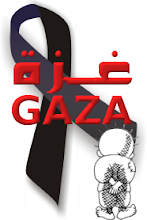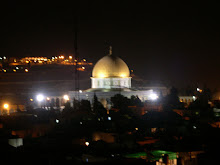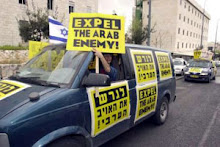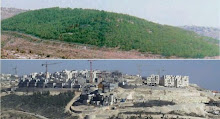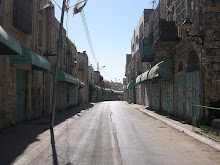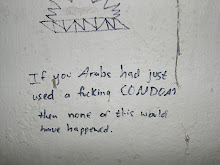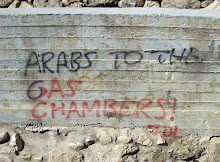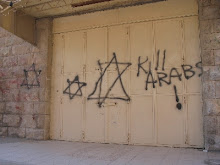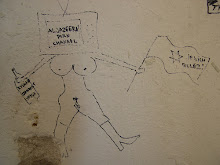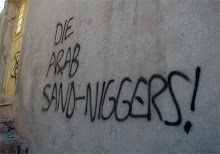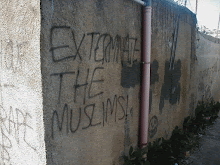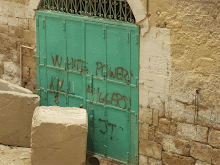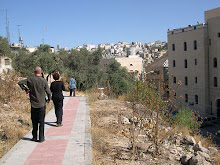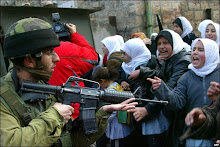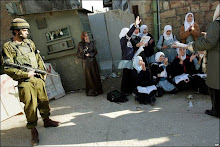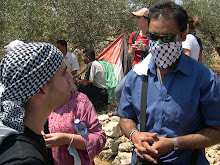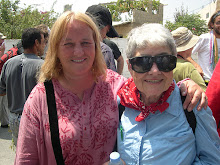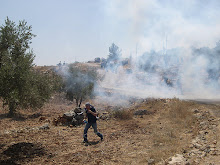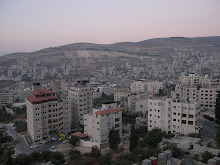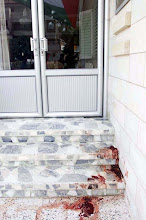 Hi all. Sorry I've been so late in posting this, Bethlehem and Hebron have been frenetic and unique. Arrived in Ramallah today and have only just sat down at leisure for the first time in 3 days.
Hi all. Sorry I've been so late in posting this, Bethlehem and Hebron have been frenetic and unique. Arrived in Ramallah today and have only just sat down at leisure for the first time in 3 days.On day 3, we took a shared Palestinian taxi from Jerusalem to Bethlehem. It is a hot, dusty drive through spectacular hills and ravines. Distances in Palestine are short- when you are not stopped at checkpoints. Half an hour after we set off, we were asked to get down by the driver. We thought there must be a problem because there was no city in sight. Sensing our confusion, he said- 'Welcome to Bethlehem'.
And what a welcome it is. The reason you don't see Bethlehem is that it is hidden by the hulking mass of the wall. The Israeli Ministry of Tourism has painted a mural on it- 'PEACE BE WITH YOU'. That must be the sickest joke ever. The checkpoint is called a 'terminal' by the Israelis. You pass through a series of turnstiles, like an airport. To our surprise, we were simply waved through- probably because we were a predominantly 'white' tourist group. However we witnessed a female security guard harassing a queue of Palestinians trying to cross. The turnstiles are so narrow that if you have anything more than a small bag, you get stuck. There are no other provisions for pregnant women or people in wheelchairs.
We proceeded to Beit Sahour, a suburb of Bethlehem where our hosts the Alternative Tourism Group http://www.atg.ps/ are based. We were warmly received by JM, who has a limp from being shot in the leg. We learnt that Beit Sahour is a predominantly Christian town which played a huge role in the second Intifada- people burnt their Israeli ID cards and refused to pay their taxes. As a result a continuous curfew was imposed for 42 days.
We were then taken out by the Palestinian Medical Relief Society (PMRS) to a house in Bethlehem encircled on 3 sides by the Wall. All you can see from this house is, well, the Wall. You do not realize how imposing the Wall is until you are next to it. It is a mammoth structure, topped with barbed wire. The owner of the house, Claire Anastas, came out to meet us. She explained how she was from an affluent family running several businesses, but since the Wall appeared they are forbidden- and physically unable- to see their clients on the other side. As a result they are in dire straits now. She has already been interviewed by several foreign news channels and asked us, 'What is the world doing about this? People come and ask questions but nothing happens. I don't understand politics. I only want to live a life. Why are we being punished like this?' The despair in her voice moved us to tears. Near Claire's house is Aida refugee camp which depends a lot on olive groves to sustain itself. The Wall has separated the two. You can imagine the consequences.
We were then taken to the villages of Wadi Nis and Umm Salamona which cultivate grapes and olives. The Wall is under construction here, with the aim of annexing the illegal settlements of Homa, Har Homa and Gilo to Jerusalem. Again, these settlements are on Palestinian land. The course of the Wall has not been decided yet but the villages are likely to be cut off from their fields. The local residents, whose leader we met, are fighting a desperate battle to prevent this from happening. They have a nonviolent protest every Friday which is regularly teargassed.
Standing on top of the hill in Wadi Nis, you get a bird's eye view of the area. The once beautiful landscape has been defaced by illegal settlements and the Wall. Har Homa stands on top of a hill which was once home to 40000 olive trees. These were cut down and destroyed by the Israelis to build Har Homa. Some were re-planted to beautify the settlements! To a Palestinian, the tree is life. It takes decades to bear fruit. Yet the Israelis have literally shaved the hills bare.
We then proceeded to meet our families. Let me explain- ATG put us up with Palestinian families in their homes. Our hostess was a delightful middle-aged Christian lady called H. Her family have lived in Beit Sahour for generations. They have always been politically active, indeed her son was put in jail for 10 months at the age of only 15 for simply protesting peacefully. He is a hotel management graduate who is now forced to work as a waiter because tourism in Bethlehem has died and WB residents are forbidden to travel to Jerusalem to find work. He could leave for abroad but never will as that would be an admission of defeat.
H told us how the families of Beit Sahour supported each other during the siege. People with food would supply those without by going from door to door in the dead of night, even though they could be shot for breaking the curfew. H said, 'even if we are left with no food and no clothes, we shall never give in. Our quarrel is not with the Jews. It is with Israel. We will not allow them to steal our dignity- which is all we have left'. She then proceeded to ply us with Palestinian food and sweets.
Day 4 was in Bethlehem as well. We were taken round by A, another Christian man whose family have been in Beit Sahour for centuries. He has spent years in jail. He was pursuing a degree at Bethlehem University when the Israelis closed it for 3 years. He was unable to complete his education, and is now working as a tour guide. He took us round more confiscated lands, settlements and barriers. And we got more and more depressed. We had some fascinating political discussions with A. Once thing that came through in our time spent with H and A is the unity displayed by Muslims and Christians. 'We are one people. Religion is not an issue. We are all Palestinians first', said A. We witnessed this in the streets- girls in hijab linking arms with girls wearing Christian crosses, and elderly men of the two faiths playing chess on the sidewalks. The rest of the world has a thing or two to learn from these wonderful people.
We got taken to the village of Beit Jala which is on top of a hill. Most of Beit Jala's land has already been usurped by the wall and the settlements. We also saw several bombed-out houses from the 2002 incursions.
We also had the chance to visit Aida and Deheisheh refugee camps. It is impossible to describe how crowded a camp is if you haven't seen one. In the case of Deheisheh, 11000 people are crammed into an area of 1 sq km. We visited the home of a 107-year-old man who lost his teenage grandson to an Israeli bullet. People ask me why Palestinian children throw stones. What harm does a stone do to a tank or a soldier wearing armour? Shouldn't the question be- why does the Israeli army shoot children throwing stones?
Our visit ended with a tour of the Church of the Nativity, where Jesus is said to have been born. This is the oldest church in the world- a huge structure, still in use for services and events like weddings. We were fortunate enough that a wedding was in process during our visit. A sound we had never heard before- Christian hymns in Arabic, set to organ music- filled the building. We visited the basement where you can see the manger in which the infant Jesus is said to have laid.
You can also see the bullet marks from the Israeli siege of the Church in 2002. When the military invaded Bethlehem, people of both faiths took refuge in the Church assuming that it would be safe, being a place of worship. However it was shelled by the Israeli forces- they respect nothing and nobody. Many died in the siege. I could sense the frustration of the Christians we met- they cannot understand why there wasn't a bigger outcry among the Christians of the world when the birthplace of their faith was being desecrated. They find it inexplicable that a large segment of Christians- the evangelicals- actually support Israel in its evil policies.
And the desecration of this once beautiful city perched on a hill continues- with the extension of the rapacious settlements and the wretched Wall, continuously gobbling up precious land and ruining the ecology. Not to mention destroying lives and livelihoods.
We ended the day by meeting S, a British surgeon who has been operating in the area for two years. She specializes in plastic and reconstructive surgery but has given up a potentially lucrative career in Britain. She is completely committed to the Palestinian cause, and intends to continue working here for as long as she is permitted.
We spent another evening with H, and had another fantastic Arab meal. We said our goodbyes and promised to stay in touch.
Tomorrow we go to Hebron. One of the scariest places on earth.


